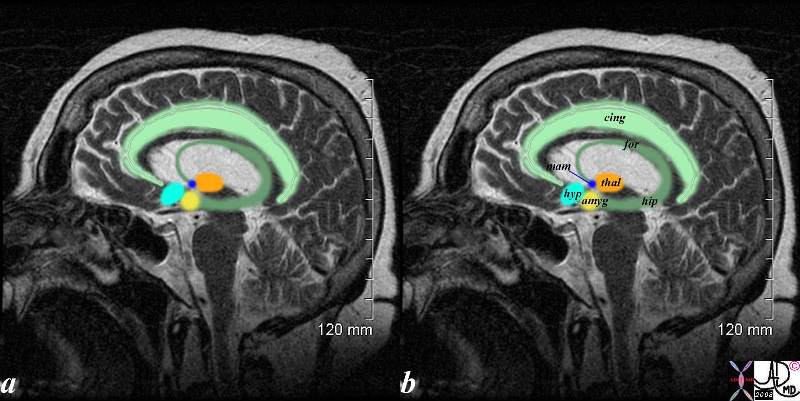Limbic System
The Common Vein Copyright 2008
Definition
The limbic system or Paleomammalian brain is embryologically the first part to develop and from an evolutionary standpoint the oldest part of the brain. Limbus is the Latin word belt and was presumably used to name the complex because of the belt like shape of many of the structures. It is made up of a group of cortical and subcortical brain structures that are responsible for very basic instinctual functions that regulate emotion and behaviour.
Structurally there are many parts that are commonly associated with the system and others that have been traditionally associated with the system. The primary structures include the amygdala, hippocampus, parahippocampal gyrus, cingulate gyrus, fornix, hypothalamus as well as anterior thalamic nuclii. Other structures that have been associated with the limbic system include mamillary body, pituitary gland, fornicate gyrus, olfactory bulb, orbitofrontal cortex, nucleus acumbens and dentate gyrus. It has important connections to the prefrontal cortex.
Functionally the limbic system contains and controls basic instinctual components for survival. The limbic system is intimately integrated with the endocrine system the autonomic nervous system and the prefrontal cortex. The functions include basic behavioural characteristics such as fear, pleasure, sexual arousal, sleep, wakefulness, thirst, hunger, flight and fight response, long term memory which are all integrated with prefrontal cortex – the concious element.
Each of the components have a specific role top play
The following list of the major components and their basic functions.
The amygdala, is associated with such responses as fear and reward as well as social functions.
The hippocampus, plays a role in long term memory.
The fornix transports signals from the hippocampus to the mamillary bodies which are involved with memory.
The cingulate gyrus, and hypothalamus are associated with the autonomic nervous system. While the cingulated gyrus also has cognitive function and attention components the kypothalamus links to the pituitary function awhich links to blood pressure, heart rate hunger thirst sexual arousal and sleep and wakefulness fornix, hypothalamus as well as anterior thalamic nuclii.
The thalamus enables all the functions to connect with one another.
Other structures that have been associated with the limbic system include mamillary body, pituitary gland, fornicate gyrus, olfactory bulb, orbitofrontal cortex, nucleus acumbens and dentate gyrus. It has important connections to the prefrontal cortex.
.

Major Parts of the Limbic System |
| Thediagram is an overlay of a sagittal view of the brain using a T2 weighted image that traverseds the centre of the brain. The limbic system is a bilateral relatively centrally placed system. The top and largest belt (light green) is the cingulate gyrus. (cin) The second, smaller and inner belt (olive green )represents the fornix (for) superiorly and the hippocampus (hip) inferiorly that terminates in the amygdala (amyg yellow) which is close association with the thalamus (orange) and hypothalamus (hyp – teal blue). The mamillary body (royal blue can be seen at the anterior and inferior end of the fornix.
71430.85c01s brain pain limbic system belt cingulate gyrus cingulate cortex hypothalamus mamillary body fornix hippocampus amygdala thalamus MRI T2 weighted Courtesy Ashley Davidoff MD copyright 2008 |
